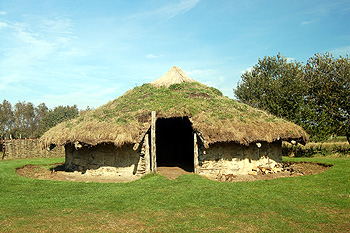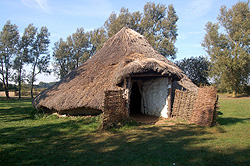Prehistoric and Roman Chellington
This page was contributed by Pamela Hider

A reconstruction of an Bronze Age round house at Flag Fen October 2011
The Bedfordshire Historic Environment Record [HER] records every prehistoric find and site known in the county. It may now be found on-line at the Heritage Gateway website.
The earliest known trace of human activity in what is now Chellington is thought to date back to the Bronze Age (c.2700BC-700BC). Travel may have been largely by water and so Chellington's situation on the south bank of a major navigable river would have been optimal.
Where settlements of people have dug trenches, engaged in funerary practices, deposited materials or marked out roads, among other things, the condition of the land is affected. This in turn affects how crops grow on that land centuries later. These patterns in the colour and depth of the crops can sometimes only be observed from the air, helping us to identify areas of archaeological importance. These are known as crop marks.

A reconstruction of an Iron Age round house at Flag Fen October 2011
In Chellington, 2 main areas of human activity can be identified stretching across the Bronze age and Iron age (c.700BC - AD43) :
Two converging pit alignments and ring ditch of probable Iron Age date are visible as cropmarks on aerial photographs of 2006. They are located in the field sandwiched between the Sewage Works and Carlton Road, north of Carlton village; also visible are possibly the remains of a Bronze Age round barrow (burial mound).
Further north east, between Woodside House and the river, is a linear cropmark reminiscent of Bronze Age barrows adjacent to the Great Ouse in Felmersham.
Findings of Artefacts

Bow brooch (sketch courtesy of HER)
Amongst items recorded by HER are:
- A Bow Brooch found NW of Lodge Farm close to Felmersham Road. It dates from the end of the Iron Age to the early decades of Roman occupation.
- Scatters of Roman pottery found NE of Lodge Farm and also in the field between Felmersham Road and the River Great Ouse.
More detailed information on both cropmarks and artefacts is given on the Heritage Gateway website.